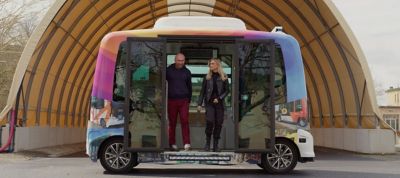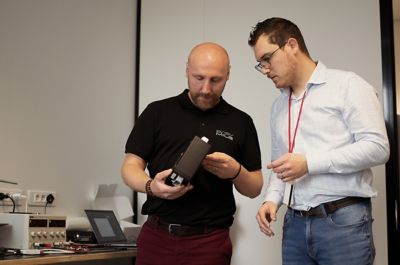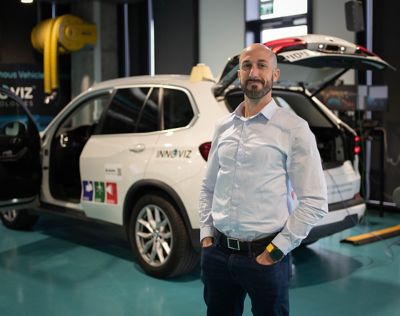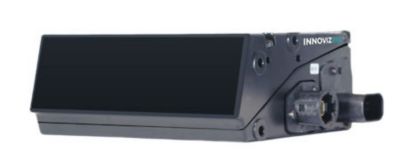-
United States -
United Kingdom -
India -
France -
Deutschland -
Italia -
日本 -
대한민국 -
中国 -
台灣
-
Ansys s'engage à préparer les étudiants d'aujourd'hui à la réussite, en leur fournissant gratuitement un logiciel de simulation.
-
Ansys s'engage à préparer les étudiants d'aujourd'hui à la réussite, en leur fournissant gratuitement un logiciel de simulation.
-
Ansys s'engage à préparer les étudiants d'aujourd'hui à la réussite, en leur fournissant gratuitement un logiciel de simulation.
-
Contactez-nous -
Carrières -
Étudiants et universitaires -
-
S'inscrire -
Déconnexion -
Espace client -
Support -
Communautés partenaires -
Contacter le service commercial
Pour les États-Unis et le Canada
+1 844.462.6797
-
ANSYS BLOG
September 11, 2023
How Simulation is Changing Perceptions of Self-driving Tech
Tune in to Episode 2 of Driven by Simulation to discover the exciting advancements EasyMile and Innoviz Technologies are making for safer driverless vehicles.
While opinions on the adoption of autonomous vehicles (AV) vary, one thing’s for certain: Self-driving technology is one of the biggest emerging markets in the automotive space. By 2035, autonomous driving is projected to create $300 billion to $400 billion in revenue in the passenger car market.
Still, for any autonomous vehicle to safely perform without human intervention, it must be able to see, analyze, and act upon the immediate environment more consistently, even better than a human driver possibly could.
Mastering autonomous tech sufficient to achieve this level of performance is no small feat. Be it advanced AVs or partially autonomous vehicles with ADAS features, both rely on a complex network of lidars, radars, cameras, and GPS hardware along with the navigational software needed to collect and process data critical to vehicle surroundings. To get from point A to point B safely, AVs need 360-degree views of the environment, which is precisely what this sensor architecture is striving to provide.
The second episode of our online docuseries, Driven by Simulation, explores the work of two startups: EasyMile and Innoviz Technologies. Both are using Ansys simulation to improve perception around the driverless technologies of the future in more ways than one.
EasyMile Shuttle Demonstrates Electric, Autonomous Vehicle Safety
Which electric vehicle (EV) can move up to 12 people comfortably, see up to 320 feet (97 meters) ahead, and 130 feet (40 meters) on either side while moving at 25 mph (40 kph) for up to 16 hours on one battery charge without a driver?

Romain Dupont, Safety and Cybersecurity Manager at EasyMile, and Driven by Simulation host Miss Emma Walsh step out of the EasyMile EZ10 autonomous shuttle.
It’s the EZ10, EasyMile’s driverless all-electric shuttle that operates at Level 4 (L4) autonomy. At this level, while most vehicles still require a safety operator present, there is no human supervisor onboard the EZ10 during operation. Instead, its movements are monitored remotely while performing within specified operating domains.
After almost seven years of operation, these vehicles continue to wind their way through college and corporate campuses, hospitals, stadiums, and city centers in places like Denver, Colorado; Toulouse, France; Berlin, Germany; Adelaide, Australia; and Singapore, Southeast Asia, to name a few.
Based on the shuttle’s success, EasyMile has also extended the same level of autonomy to TractEasy, an autonomous tractor designed for material handling and industrial environments.
Of course, the EZ10 isn’t traveling at the speeds a traditional passenger vehicle might. However, whether you’re traversing city streets or your local university, safety is the top consideration. The shuttle needs to see past any roadblocks that could compromise its operation, including pedestrians, vehicles, or other objects that cross its path.

EasyMile’s Romain Dupont (left) and Julien Martin inspect a safety calculator.
An in-house EasyMile software package and embedded system act as the “brains” central to vehicle operation and helps automate both the EZ10 and TractEasy transportation platforms. The software coordinates with numerous vehicle sensors to collect data on the surroundings, which is shared with EasyMile to provide localization, perception, and path planning. The harmonious interaction of these technologies results in more automated, less infrastructure-centric environments.
Ansys medini analyze, with support from Ansys and Ansys Elite Channel Partner CADFEM, helps sort through the complexity of all of this data to define and demonstrate the safety of EasyMile’s autonomous products. Specifically, medini analyze acts as a turnkey solution that includes all of the tools needed to conduct the level of safety analysis required by EasyMile’s customers, and to provide necessary safety documentation needed for regulators.
Also top of mind for EasyMile is cybersecurity. The threat of hacking by foreign actors can significantly impact operational safety, an activity that can be mitigated preemptively by EasyMile with the help of Ansys solutions.
“We do a lot of analysis with Ansys solutions like medini analyze in order to model the complex systems against all the potential scenarios, and then we switch to the integration and simulation tools in order to see if all of the additional safety and cyber systems we recommend for safety and cybersecurity work well,” says Romain Dupont, Safety and Cybersecurity Manager at EasyMile. “We do cyberattacks in the end to prove that it works well for our customer to present to regulation authorities, but also to a safety assessor in order to get a stamp at the end saying we’re approved, and all the attacks are known and well-managed.”
Innoviz Technologies Builds a Better Lidar
When you consider that human error accounts for a huge number of vehicle accidents, then removing the driver from the equation is a logical next step to safer automobile travel. In a new, driverless reality, vehicle perception is everything. Sensing tech holds the key to overcoming perception challenges in both driver-assisted and driverless environments.

Oren Buskila, Chief R&D Officer and Co-founder at Innoviz Technologies
The second half of Driven by Simulation, episode 2 drills down on Innoviz Technologies’ lidar that enables a car to interpret variable distance between itself and another object in its path.
Lidar is coveted by original equipment manufacturers and automotive suppliers for its ability to capture high-resolution, long-range 3D images. By sending light beams in all directions via pulsed laser, an object’s distance from a vehicle can be calculated based on beam bounce back to a laser scanner. Recording each laser beam’s reflection point, an onboard computer generates a point cloud, which is a 3D representation of the objects around it.
This explanation of Innoviz lidar sounds simple enough. But for OEMs, lidar must meet performance, reliability, and cost requirements in a more compact design — a rarity in the marketplace. Producing a new design using a traditional build-test-iterate approach can take years. Additionally, the solution must be designed to the highest level of accuracy before production, which often results in a long development arc defined by a costly number of iterations.


Innoviz used Ansys simulation software to help develop its InnovizOne solid-state lidar.
To address these challenges, Innoviz turned to Ansys simulation to drive real, substantive change in lidar solutions. Using various Ansys products helped Innoviz streamline development and achieve its first-time validation target for its flagship product, InnovizOne solid state lidar. InnovizOne is a high-performing, low-cost lidar in a smaller package than traditional solutions.
“Developing the lidar was, and is, super challenging because we need to take so many different conditions and requirements into consideration,” says Oren Buskila, Chief R&D Officer and Co-founder at Innoviz Technologies. “We get several thousands of requirements from our customers that our product needs to comply with. And this is where simulation comes in very handy, or actually critical.”
All aspects of development were done in-house at Innoviz, enabled by many Ansys tools and solvers, including:
- Ansys Mechanical for structural analysis that leads to more robust mechanical and optical system parts.
- Ansys Fluent for thermal analysis to understand airflow around the component.
- Ansys Maxwell to understand the electromagnetic elements of individual system parts.
- Ansys Zemax OpticStudio to run both sequential and non-sequential optical simulations to achieve the desired light path integral to accurate object detection.
Tune in to Driven by Simulation to See Self-Driving in a New Light
From self-driving shuttles to the sensing technology that helps them “see” what’s ahead, EasyMile, and Innoviz are challenging (and changing) perceptions around how we’ll move.
Be sure to catch Episode 2 of Driven by Simulation to learn how Ansys is helping to bring advanced driver assisted systems and self-driving technologies to market.











